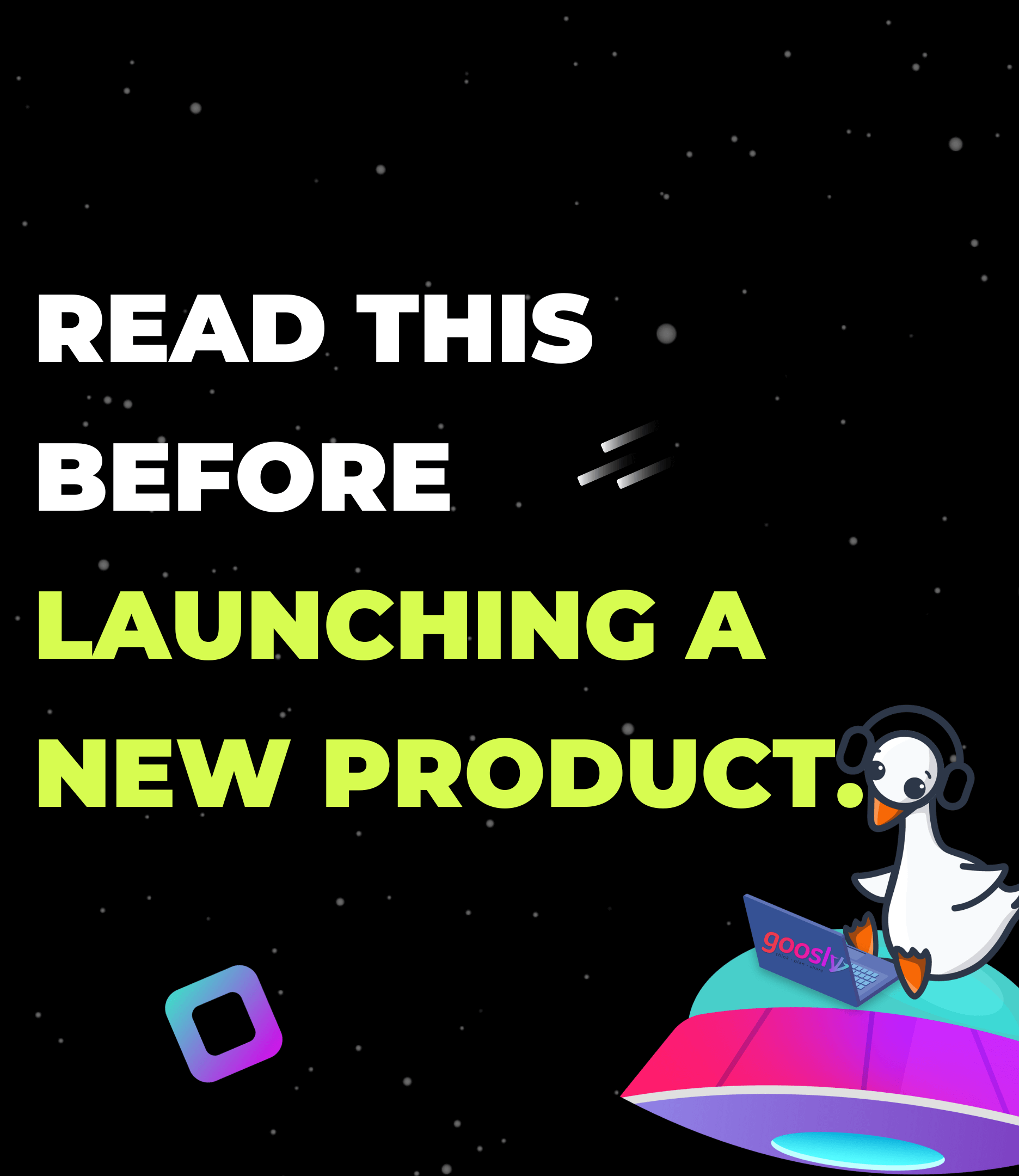What you'll get from this article:
🤔 How to avoid common mistakes during product launch planning
🚀 What makes a successful product launch
👩🏫 Tips for training your team on the new product
🎯 How to use customer and stakeholder feedback to improve the product
Launching a new product is always a challenge. There are so many things that can go wrong – and often do.
As a product manager, avoiding these common planning mistakes is essential to ensure your product launch is successful.
This blog post will discuss some of the most common mistakes people make when planning a product launch and how you can avoid them.
Planning your product launch carefully and avoiding common mistakes is crucial. Launching a product successfully requires careful planning, coordination between teams, and executing a well-thought-out strategy.
Yet, most product managers make the same mistakes when planning their product launches. These mistakes can lead to disastrous results, so it's important to be aware of them and avoid them at all costs.
The most common mistakes to look out are as follows:

1. Underestimating the time and effort needed to launch a product
Launching a new product is never easy. Planning and executing a successful product launch takes time and effort. Unfortunately, many businesses underestimate the amount of work involved, and as a result, their launches are unsuccessful. This can lead to rushed planning and execution, leading to problems down the road.

To avoid this, be realistic about your project's required time and effort, and plan accordingly. Make sure you have enough time to do everything correctly, and don’t try to rush through the process. Rushing usually leads to mistakes that must be fixed later, costing you more time and money in the long run.
2. Focusing too much on the product and not enough on the market
Many managers make the mistake of focusing too much on development and not enough on the market. This can lead to several problems, including launching a product that no one wants or needs, launching too late, and falling behind the competition.
For example, if you think your product is for a particular type of customer, but they don't actually want or need it, you're in for a rough ride. Or maybe you're targeting the wrong channels - spending all your time and money on advertising in magazines that no one reads, for instance.

There are countless ways to mess up a product launch, but luckily most of them are avoidable with careful planning. By researching and understanding your target market inside out, you'll be well on your way to launching a successful product.
It's essential to research your target market and understand their needs before starting product development. This will help ensure that you build something people want, and it will succeed in the marketplace.
3. Launching before you're ready
Managers often make the mistake of launching a product before they are ready. This can be due to several reasons, such as wanting to beat the competition or feeling pressure from above to produce results. However, rushing a product launch can have disastrous consequences for the company.
Some of the most common problems caused by launching a product too early include:
-Products that are not well-conceived or thought out
-Products that do not meet customer needs or expectations
-Products that are not adequately tested or debugged
-Products that are released before they are ready for prime time
In addition, rushed launches can damage the company's credibility and reputation and may even lead to lawsuits from customers harmed by the defective product.
One way to avoid launching a product before it is ready is to make sure you have a clear and realistic timeline for the launch. This will help you avoid rushing through the development process and ensure that everything is ready when it is time to launch.
Additionally, ensure you have a solid product launch plan for testing and debugging your product before release. For example, you can implement a product launch checklist. Having a list to follow ensures that you have covered all your bases and that your launch will go off without a hitch.
Some items that you may want to include on your product launch checklist are:
-Creating a press release
-Developing marketing materials
-Creating a website or landing page
-Setting up social media profiles
-Planning a launch event
-Contacting bloggers and other influencers
-Planning shipping and logistics
-Creating an order form or pricing sheet
By taking the time to create a comprehensive product launch strategy, you can ensure that your launch is successful and that all of the necessary planning has been done. Doing this allows you to catch any potential problems before they cause any significant issues.
Finally, be mindful of the pressure to launch a product prematurely. Managers must decide whether or not to create a product launch date. On the one hand, having a set launch date can give the team a sense of urgency and ensure that everything is ready when it is time to go live.
On the other hand, if something is not ready, it can put the team under pressure to release a product that is not ready.
To make the decision, managers should consider the following factors:
-The readiness of the product
-The availability of resources such as staff, funding, and equipment
-The competition's product timeline
-The company's ability to meet customer demands
If all of these factors indicate that the company is ready to launch a product, then a launch date can be an effective way to ensure everything goes smoothly. However, if any of these factors indicate that the company is not ready, then it may be best to delay the launch until everything is in order. Try to resist temptation unless you are confident that your product is ready for prime time.
4. Not having a clear strategy or plan
Managers may not have a clear strategy or plan for product launches. This can lead to confusion and chaos among the team and may ultimately result in a failed launch.
To ensure a successful product launch, it is crucial to have a clear strategy and plan. This includes having clearly defined goals, as well as a timeline for completing various tasks.

Having a realistic budget and preparing for potential roadblocks are also important. By planning ahead and taking the time to prepare appropriately, managers can minimize the chances of a failed product launch.
You may consider looking at programs or applications that organize a product launch.
For example, Goosly is a free web roadmap tool that helps product owners create a roadmaps for their product launches.
It allows users to track their progress against their goals and objectives. As well as sharing and embedding their roadmaps anywhere.
Goosly also provides templates for writing a marketing strategy and creating a timeline.
Using Goosly, managers can ensure they have everything they need to plan a successful product launch.
Here are some critical points to consider when creating your plan for a product launch:
-Establish your goals and objectives.
What are you hoping to achieve with your product launch? More website traffic? Increased sales? Better brand awareness? Define your goals and objectives, and make sure they are SMART: Specific, Measurable, Achievable, Relevant, and Time-bound.
-Research your competition.
What products or services do your competitors offer? What do their websites look like? What marketing strategies do they use? Do any of their products or services overlap with yours? Knowing your competition will help you develop a strategy that sets you apart.
-Create a timeline.
Product launches can be very complicated and time-consuming affairs. It’s essential to create a timeline that outlines all the steps involved in the launch process, from planning to execution. This will help you stay on track and avoid rushing through the process.
-Develop a marketing strategy.
How will you promote your product launch? What channels will you use? What message will you use? How often will you communicate with your audience? Developing a marketing strategy is essential for a successful launch.
-Create a budget.
Launching a new product can be expensive, so it’s crucial to create a budget that outlines all the costs associated with the launch. This includes advertising, PR, and staffing expenses, among others.
-Assign tasks and responsibilities.
Not everyone involved in the product launch must be responsible for every task. Assign specific duties and responsibilities to each team member and ensure everyone knows what they need to do to help ensure a successful launch.
5. Not testing your assumptions
Managers may not test their assumptions before a product launch, which can lead to disastrous consequences. To avoid these consequences, it is vital to test your assumptions and make sure you have a plan for what will happen if they are wrong. Otherwise, you may waste time and money on a product no one wants.
The four most common assumptions about a product are:
1. The product will be successful based on past successes of similar products.
Companies often look to past successes for guidance when releasing new products. If a product was successful in the past, there's a good chance that the new product will also be successful. This thinking can lead to assumptions about a product's success and cause companies to miss out on potential opportunities.
Even if a product is similar to one that was successful in the past, there's no guarantee that it will be successful again. The market may have changed since the last time the product was released, and consumer preferences may have shifted. Other companies may have also released similar products that are now more popular than the company's old ones.
2. The product addresses a need that is currently not being met by any other products.
When a new product is created, managers often assume that it addresses a need that is currently not being met by any other products. This assumption can be a powerful motivator for the team developing the product and help ensure the new product is successful.
However, if this assumption turns out to be untrue, it can be difficult for the team to recover from the failure. A reliable way to gauge the need for a new product is to look at sales numbers for similar products. If a company introduces a new product and sales for the old product continue to be high, it may indicate no need for the new product.
Alternatively, if sales for the old product drop after introducing it, it may indicate a need for the new product. Another way to gauge the demand for a new product is to conduct surveys or focus groups, which we will discuss later in this article.
3. The product is innovative and different from any other products on the market.
Managers may assume that a product is innovative and different from any other product on the market. This can be due to the features that are being advertised or the way it has been marketed. However, if this assumption is incorrect, it can lead to problems for the company.
Managers need to be sure that a product is actually new before assuming it is, and they also need to make sure that the product can be successful in the market. If a product is not truly new or does not have what it takes to be successful, then managers may waste time, money, and resources on something that will not work out in the end.
4. The target audience for the product is well-defined, and there is a large enough potential customer base to support sales growth.
Managers often mistake assuming their target market is well-defined and understood. However, this is not always the case. A recent study found that less than half of companies know their target market.
This can be a costly mistake, as it can lead to missed opportunities and inefficient marketing campaigns. Managers must take the time to understand their target market and define it accurately. This includes understanding the demographics of the target market, as well as their needs and wants.
To avoid making these common assumptions, it is important to clearly understand what you want to achieve with your launch and verify all information before taking action. By verifying all information and planning ahead, you can avoid costly mistakes and ensure a successful product launch.
6. Ignoring feedback from customers and stakeholders
It's important to get feedback from customers and other stakeholders during the product launch process. There are several great programs and strategies for testing customer and stakeholder feedback on a product.
When launching a new product, a company may use its customer support department to help spread the word. The department can provide information about the product and how to use it and answer customer questions. In addition, the department can help promote the product by sharing news about it on social media and the company's website.

One excellent option is to use software to create and send out surveys to customers or stakeholders. This can help you gather feedback on everything from the overall quality of the product to specific features or functions that are important to customers or stakeholders.
Another option is to hold focus groups or individual interviews with customers or stakeholders to get their feedback on the product. This can help you get feedback on what people like and don't like about the product and any suggestions they may have for changes or improvements.

Finally, you can also use web analytics tools to track how customers or stakeholders use the product and identify areas where they may struggle or have difficulty. This can help you pinpoint potential improvement areas based on customer or stakeholder feedback.
7. Assuming that people will just "figure it out"
When a new product is launched, many managers assume that people will just "figure it out." They may not realize that this new product launch is an entirely new experience for customers and requires training and support to succeed. The new product may not reach its full potential without proper training and support.
Here are some tips to help you get started on product training:
1. Make sure everyone on your team is familiar with the product and its features. This includes both the technical and marketing teams.
2. Train your team members on how to use the product and ensure they are familiar with its functions.
3. Provide your team with all the resources they need, including sample materials, templates, and guidelines.
4. Set up a feedback system so that team members can provide feedback on each other's work and suggest improvements.
5. Encourage creativity and innovation, and reward team members for their efforts.
In Conclusion
In conclusion, a successful product launch is crucial to any product's success, and many things can go wrong during the planning process. To avoid these mistakes, it's important to verify all information before taking action. You can ensure a successful product launch by planning and getting feedback from customers and stakeholders.
Goosly is an excellent tool for planning and executing successful product launches. With its powerful survey and feedback tools, you can gather feedback from customers and stakeholders to help make informed decisions about your product launch. In addition, its web analytics tools can help track how customers use your product and identify areas where they may struggle or have difficulty. With Goosly, you can rest assured that your product launch will be a success.
Key points from this post:
- A successful product launch is crucial to the success of any product
- To avoid mistakes, it's important to verify all information before taking any action
- You can ensure a successful product launch by planning ahead and getting feedback from customers and stakeholders

